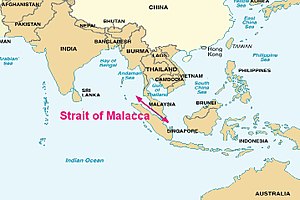
Back القرصنة في إندونيسيا Arabic Piratería en Indonesia Spanish Perompakan di Indonesia ID Pirataria na Indonésia Portuguese

Piracy in Indonesia is not only notorious, but according to a survey conducted by the International Maritime Bureau, Indonesia was the country sporting the highest rate of pirate attacks back in 2004. It subsequently dropped to second place of the world's worst country of pirate attacks in 2008, finishing just behind Nigeria.[1] However, Indonesia remains deemed the country with the world's most dangerous water due to its high piracy rate.[2]
With more than half of the world's piracy crimes surrounding the South-East Asia aquatic regions, the turmoil caused by piracy has made the Strait of Malacca a distinct pirate hotspot accounting for most of the attacks in Indonesia, making the ships that sail in this region risky ever since the Europeans arrived.[1][3] The term 'Piracy in Indonesia' includes both cases of Indonesian pirates hijacking other cargo and tanks, as well as the high rate of practising piracy within the country itself. The Strait of Malacca is also one of the world's busiest shipping routes as it accounts for more than twenty-five percent of the world's barter goods that come mainly from China and Japan.[1] Approximately 50,000 vessels worth of the world's trade employ the strait annually, including oil from the Persian Gulf and manufactured goods to the Middle East and Suez Canal. The success that stems from this trade portal makes the Strait an ideal location for pirate attacks.[4]
- ^ a b c Read, Sophia. "Piracy: Alive and Dangerous in the 21st Century". The Bali Times. Retrieved 30 March 2013.
- ^ "Sea Piracy Hits Record High". CNN. 26 January 2004. Retrieved 30 March 2013.
- ^ "Indonesia Piracy Hotspot". BBC. 1 November 2000. Retrieved 31 March 2013.
- ^ Schuman, Michael (22 April 2009). "How to Defeat Pirates: Success in the Strait". Time World. Archived from the original on 1 May 2013. Retrieved 30 April 2013.